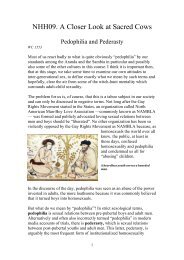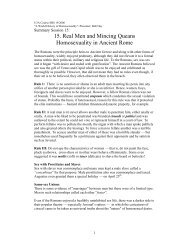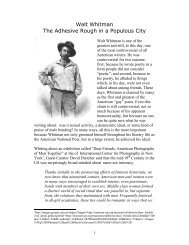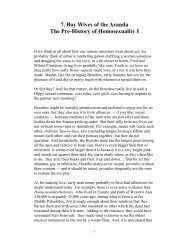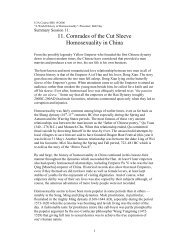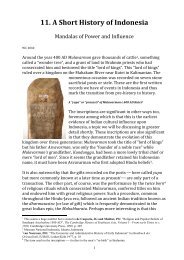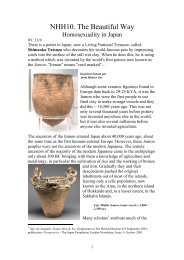10. The Beautiful Way Homosexuality in Japan
10. The Beautiful Way Homosexuality in Japan
10. The Beautiful Way Homosexuality in Japan
You also want an ePaper? Increase the reach of your titles
YUMPU automatically turns print PDFs into web optimized ePapers that Google loves.
the world of the nobles and the warriors, lovers would swear<br />
perfect and eternal love rely<strong>in</strong>g on no more than their mutual good<br />
will. Whether their partners were noble or common, rich or poor,<br />
was absolutely of no importance… In all these case they were<br />
greatly moved by the spirit of this way. This way must be truly<br />
respected, and it must never be permitted to disappear.”<br />
Fortunately, we can get a glimpse of the “beautiful way” at the movies<br />
with the 1999 film, released <strong>in</strong> Australia under the title of “Taboo” but<br />
orig<strong>in</strong>ally called “Gohatto”, directed by Nagisa Oshima (Merry<br />
Christmas Mr Lawrence, In the Realm of the Senses, etc). In this<br />
sensual and dream-like movie set <strong>in</strong> 1865, three years before the fall of<br />
the Tokugawa shogunate, we see the havoc a very beautiful if flirtatious<br />
youth creates when he jo<strong>in</strong>s a group of samurai, several of whom then<br />
compete with each other for his favours.<br />
<strong>The</strong> same anonymous Androphile author also writes:<br />
Known also as wakashudo, “the way of the youth”, it was a<br />
practice engaged <strong>in</strong> by all members of the samurai class, from<br />
lowliest warrior to highest lord. Indeed it has been said that it<br />
would never have been asked of a daimyo, ( or lord), why he took<br />
boys as lovers, but why he didn’t. This last is not a question that<br />
would have troubled, for example, the three great shoguns who<br />
unified <strong>Japan</strong>, Oda Nobunaga, Toyotomi Hideyoshi, or Tokugawa<br />
Ieyasu, nor for that matter Miyamoto Musashi, the author of “<strong>The</strong><br />
Book of Five R<strong>in</strong>gs.” 7<br />
Although <strong>in</strong> many ways like pederasty <strong>in</strong> Ancient Greece, wakashudo —<br />
usually abbreviated to shudo —differed <strong>in</strong> one major respect <strong>in</strong> that <strong>in</strong><br />
<strong>Japan</strong> it was the adolescent youth who sought out and wooed the older<br />
man, and not the other way around as <strong>in</strong> Greece. However, as <strong>in</strong> Greece,<br />
the sexual part of the relationship customarily ended when the youth<br />
reached manhood, usually around age 19 or so. Of course that did not<br />
mean the men ceased to know each other: most commonly a close<br />
friendship lasted for the rest of their lives and, <strong>in</strong> some cases, the men<br />
cont<strong>in</strong>ued the erotic relationship long past the conventional time. As <strong>in</strong><br />
Greece, this shudo relationship did not rule out marriage because most<br />
7 Gary P. Leupp, 1995, Male Colors, the Construction of <strong>Homosexuality</strong> <strong>in</strong> Tokugawa<br />
<strong>Japan</strong>, Berkely, <strong>The</strong> University of California Press, p. 53. <strong>The</strong> “Book of 5 R<strong>in</strong>gs”,<br />
accord<strong>in</strong>g to Wikipedia, is “an enigmatic book of strategy, tactics, and philosophy<br />
used as the personal mantras for bus<strong>in</strong>esspeople and martial artists alike” written by<br />
Miyamoto Musashi who is regarded as the greatest swordsman ever <strong>in</strong> <strong>Japan</strong>..<br />
7



